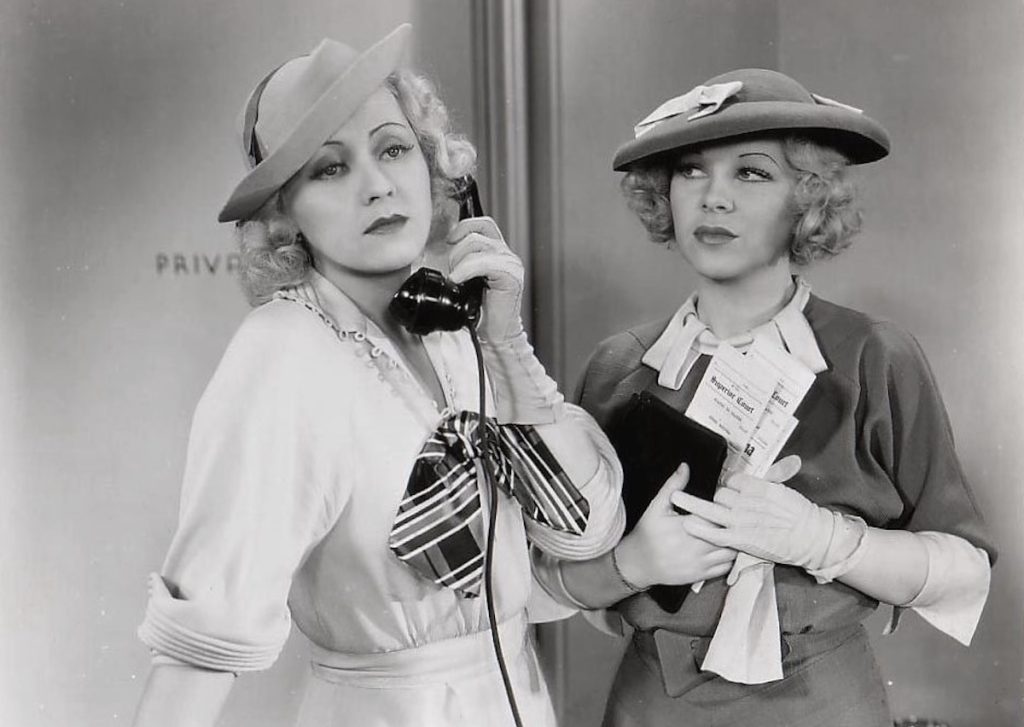When TCM airs We’re in the Money on August 11, it will offer a relatively rare chance to catch the comedy starring Joan Blondell and Glenda Farrell, which was released 90 years ago this week. The 1935 film isn’t available to stream or rent digitally and has never been released on DVD, making it the rarest of the seven comedies that Blondell and Farrell made together between 1933 and 1936, when Warner Bros. briefly attempted to establish the longtime friends as a headlining duo. It’s also the best of those movies, although Blondell and Farrell’s charm shines through in all of their joint appearances, even when they aren’t the main attraction.
To Warner Bros.’ credit, the studio never tried to make Blondell and Farrell into inferior copies of popular male comedy teams of the time, mimicking Laurel and Hardy or the Marx Brothers. They’re closer to more modern comedy pairings, like Gene Wilder and Richard Pryor or Tina Fey and Amy Poehler, taking on different roles in each movie while retaining the chemistry that makes them so entertaining to watch together.
The most effective Blondell/Farrell movies feature their characters working as a team, and they’re often literally arm-in-arm in We’re in the Money, in which they play a pair of sassy process servers working for absent-minded lawyer Homer Bronson (Hugh Herbert). The movie opens with Blondell’s Ginger Stewart making out on a park bench with her paramour C. Richard Courtney (Ross Alexander), a rich heir who’s passed himself off as a chauffeur while courting the working-class Ginger.
Just as they’re making gooey declarations of love to each other, Farrell’s Dixie Tilton pierces the romantic bubble with a car horn, reminding Ginger of the urgency of their next errand. They make their way to a men’s-only spa, where they barge in to serve a subpoena to a publisher while he’s in the steam room. “For $1,000, we’d make a sap out of any man,” Dixie tells Homer when he begs them to take one last job before quitting, to track down four elusive witnesses in a breach-of-promise suit.
That could be the mission statement for the Blondell/Farrell oeuvre, most of which features them as good-natured gold-diggers of one type or another. Brazen female gold diggers were a staple of pre-Code cinema, and while the Blondell/Farrell films were made both before and after the implementation of the Production Code, they all rely on the same fast-paced, entendre-laden dialogue, with bold, independent female characters.
“All you ever think about is money,” Ginger says to Dixie toward the end of We’re in the Money, as Ginger is still pining for Courtney despite multiple reveals and reversals. “Well, what else is there, love?” Dixie scoffs. Farrell’s characters fall in love, too, but often only as an afterthought while Blondell ends up with the leading man. We’re in the Money doesn’t saddle Dixie with an extraneous love interest, instead positioning her as Ginger’s support system even when she disapproves of her friend’s choice in men. She’d make a sap out of any man for money, but she’d never make a sap out of Ginger.
Like almost all Blondell/Farrell comedies, We’re in the Money has a running time under 70 minutes, with breakneck pacing that finds room for multiple car and boat chases, an entire pro wrestling match featuring real-life wrestler Man Mountain Dean playing himself, a full courtroom trial, and a climactic rush to stop a wedding. The plotting is slightly less chaotic than 1933’s Havana Widows or 1934’s Kansas City Princess, both of which take Blondell and Farrell on whirlwind international tours, but it’s still often as overwhelming as Homer’s reckless driving, never stopping long enough to let the characters or the audience catch their breath.
Blondell and Farrell were often supported by the same male co-stars, including Allen Jenkins, Osgood Perkins (yes, the filmmaker’s grandfather), Hobart Cavanaugh, and Herbert, whose own well-defined comedic persona mixes perfectly with Blondell and Farrell’s sharp-tongued wit. With his signature giggle, Herbert frequently played cheerful dopes, and he personifies the obliviousness of privilege in his four appearances in Blondell/Farrell movies.
There isn’t much time to think about class consciousness while watching these fast-moving comedies, but it’s clear that Blondell and Farrell characters must rely on their charm and attractiveness to get ahead in a world that’s set up to dismiss and devalue them. In Havana Widows, they scheme to frame a wealthy man in a compromising position so they can cash in with a lawsuit. In 1935’s Miss Pacific Fleet, they try to rig a beauty contest so Blondell’s character can win the prize money. Even in 1935’s Traveling Saleslady, in which they both play successful businesswomen, they’re forced to use subterfuge and seduction to prove that they’re as smart and savvy as the men who dismiss them.
Traveling Saleslady positions Blondell and Farrell as romantic rivals, and Farrell is limited to a small supporting role in 1934’s I’ve Got Your Number. But when they’re acting as a team, coming up with elaborate plans to deliver subpoenas in We’re in the Money or traveling in disguise to avoid a vengeful gangster in Kansas City Princess, they’re every bit as fresh, funny, and creative as any male comedy act from the same era.
Blondell and Farrell are both classic Hollywood icons with plenty of major credits, but aside from musical extravaganza Gold Diggers of 1937, their film collaborations are relegated to manufacture-on-demand DVDs and occasional TCM airings. Anyone who watches We’re in the Money on TCM next week will see clearly why that’s a cinematic injustice.

